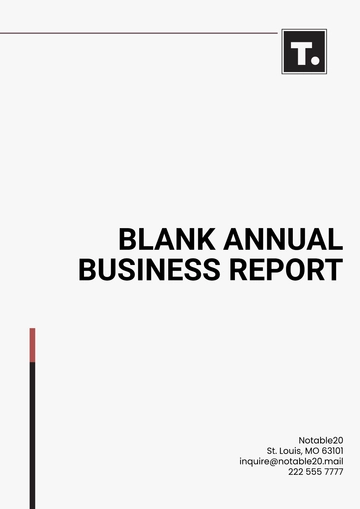Free Agriculture Business Report

Executive Summary
This comprehensive Agriculture Business Report is prepared by [Your Company Name], a leader in sustainable agriculture, to provide an in-depth analysis of our current operations, market position, financial performance, and future strategic plans. This report outlines the key aspects of our business, including our vision, objectives, infrastructure, market analysis, financial health, and future growth strategies. The report is intended to inform stakeholders, including investors, employees, and industry partners, about our business's status and future direction.
1. Business Overview
1.1 Company Background
[Your Company Name] was established in 2038 with a mission to produce high-quality agricultural products using sustainable farming practices. Our headquarters is located in [Location], and our operations span 2,000 acres of fertile land. We specialize in the cultivation of [specific crops] and the production of [related products]. Our commitment to sustainability and innovation has positioned us as a trusted name in the agricultural sector.
1.2 Vision and Objectives
Our vision is to become the leading provider of sustainable agricultural products in the region. Our key objectives for the next five years include:
Increase Crop Production: Aim to increase crop production by 50%.
Reduce Carbon Footprint: Target a 20% reduction in our carbon footprint.
Expand Market Reach: Increase market penetration nationally and internationally.
Innovate Farming Techniques: Implement cutting-edge farming techniques to improve efficiency and yield.
1.3 Current Infrastructure
Our current infrastructure supports our robust operations and includes:
Cultivated Land: 2,000 acres of prime agricultural land.
Storage Facilities: 10 storage facilities with a total capacity of 500,000 bushels.
Irrigation Systems: Advanced irrigation systems covering 80% of the cultivated area.
Farm Machinery: 50 units of modern farm machinery, including tractors, harvesters, and seeders.
2. Market Analysis
2.1 Industry Overview
The agricultural industry is a critical sector of the economy, providing essential food products and raw materials. The industry is characterized by a growing demand for sustainable and organic products, driven by increasing consumer awareness of environmental issues and health benefits. Technological advancements and innovations in farming practices are also shaping the industry's future.
2.2 Market Trends
Key trends impacting the agricultural market include:
Sustainable Farming: Growing emphasis on sustainable farming practices to reduce environmental impact.
Organic Products: Rising demand for organic and non-GMO products.
Technological Integration: Adoption of advanced technologies, such as precision farming, AI, and IoT, to enhance productivity and efficiency.
Global Trade: Increasing globalization and international trade agreements opening new markets for agricultural products.
2.3 Competitive Landscape
[Your Company Name] operates in a highly competitive market. Key competitors include [Competitor 1], [Competitor 2], and [Competitor 3]. Our competitive advantages include:
Sustainability: Strong commitment to sustainable farming practices.
Innovation: Continuous investment in research and development.
Quality: High-quality products with a focus on organic and non-GMO options.
Customer Relationships: Strong relationships with customers and suppliers.
3. Financial Performance
3.1 Historical Financial Performance
Our financial performance over the past five years has shown steady growth in revenue and profitability. Key financial highlights include:
Year | Revenue ($) | Net Profit ($) | Profit Margin (%) |
|---|---|---|---|
2045 | 5,000,000 | 500,000 | 10 |
2046 | 5,500,000 | 600,000 | 10.9 |
2047 | 6,050,000 | 700,000 | 11.6 |
2048 | 6,655,000 | 805,000 | 12.1 |
2049 | 7,320,500 | 925,750 | 12.6 |
3.2 Financial Ratios
Key financial ratios for the last fiscal year include:
Ratio | Value |
|---|---|
Current Ratio | 2.1:1 |
Debt-to-Equity Ratio | 1.3:1 |
Return on Assets (ROA) | 8.5% |
Return on Equity (ROE) | 15.2% |
3.3 Financial Projections
Our financial projections for the next five years, based on current growth trends and strategic initiatives, are as follows:
Year | Projected Revenue ($) | Projected Net Profit ($) | Projected Profit Margin (%) |
|---|---|---|---|
2050 | 8,052,550 | 1,050,250 | 13.0 |
2051 | 8,857,805 | 1,205,288 | 13.6 |
2052 | 9,743,585 | 1,385,600 | 14.2 |
2053 | 10,717,944 | 1,593,440 | 14.9 |
2054 | 11,789,739 | 1,832,456 | 15.5 |
4. Strategic Initiatives
4.1 Expansion of Cultivated Land
We plan to acquire an additional 500 acres of land to increase our production capacity by 25%. This expansion is crucial to meet the growing demand for our products and maintain a competitive edge in the market.
4.2 Technological Upgrades
Investing in state-of-the-art machinery and equipment will improve our operational efficiency and reduce labor costs. The upgrades will include purchasing new tractors, harvesters, and automated seeders, which are essential for modern farming practices.
4.3 Research and Development
Allocating funds to research and development will enable us to explore and implement innovative farming techniques. This includes experimenting with new crop varieties, improving pest control methods, and enhancing soil health.
4.4 Sustainability Initiatives
Our commitment to sustainability includes installing advanced irrigation systems to improve water use efficiency and reduce our environmental impact. We are also exploring renewable energy sources to power our operations.
5. Operations
5.1 Production Processes
Our production processes are designed to ensure the highest quality standards while maintaining efficiency and sustainability. Key processes include:
Soil Preparation: Using organic fertilizers and compost to enhance soil fertility.
Planting: Precision planting techniques to optimize crop density and yield.
Irrigation: Advanced irrigation systems to ensure efficient water use.
Pest Management: Integrated pest management (IPM) practices to minimize chemical use.
Harvesting: Mechanized harvesting to reduce labor costs and increase efficiency.
5.2 Quality Control
Quality control is integral to our operations. We have implemented stringent quality control measures at every stage of production, from planting to harvesting and storage. Our quality control team conducts regular inspections and testing to ensure compliance with industry standards and customer expectations.
5.3 Supply Chain Management
Efficient supply chain management is critical to our success. Our supply chain strategy includes:
Supplier Relationships: Building strong relationships with reliable suppliers to ensure a steady supply of high-quality inputs.
Inventory Management: Implementing advanced inventory management systems to minimize waste and optimize storage.
Distribution: Leveraging a robust distribution network to ensure timely delivery of products to customers.
6. Human Resources
6.1 Workforce Overview
Our dedicated workforce is a key asset to our company. We employ over 100 full-time workers, including skilled laborers, agronomists, and administrative staff. We are committed to providing a safe and supportive work environment that encourages professional growth and development.
6.2 Training and Development
Investing in our employees is essential for our long-term success. Our training and development programs include:
Technical Training: Regular training sessions on the latest farming techniques and equipment.
Safety Training: Comprehensive safety training to ensure a safe working environment.
Leadership Development: Programs to develop leadership skills and prepare employees for advanced roles.
6.3 Employee Engagement
We believe that engaged employees are more productive and committed to the company’s success. Our employee engagement initiatives include:
Regular Communication: Open communication channels to keep employees informed and involved in decision-making.
Recognition Programs: Recognizing and rewarding employees for their contributions and achievements.
Work-Life Balance: Promoting a healthy work-life balance through flexible work schedules and support programs.
7. Marketing and Sales
7.1 Marketing Strategy
Our marketing strategy is designed to build brand awareness, attract new customers, and retain existing ones. Key elements of our marketing strategy include:
Brand Positioning: Positioning [Your Company Name] as a leader in sustainable agriculture.
Digital Marketing: Leveraging digital marketing channels, including social media, email marketing, and SEO, to reach a wider audience.
Content Marketing: Creating valuable content to educate and engage our target audience.
Partnerships: Building strategic partnerships with industry organizations and influencers to enhance our brand credibility.
7.2 Sales Strategy
Our sales strategy focuses on expanding our market reach and increasing sales volume. Key elements of our sales strategy include:
Market Penetration: Expanding our presence in existing markets through targeted sales efforts.
New Market Development: Exploring new markets nationally and internationally to increase sales.
Customer Relationship Management: Building strong relationships with customers to enhance loyalty and repeat business.
Sales Team Training: Regular training for our sales team to improve their skills and effectiveness.
7.3 Sales Performance
Our sales performance over the past five years has shown steady growth, reflecting the effectiveness of our marketing and sales strategies. Key sales metrics include:
Year | Sales Volume (units) | Revenue ($) | Sales Growth (%) |
|---|---|---|---|
2045 | 100,000 | 5,000,000 | 10 |
2046 | 110,000 | 5,500,000 | 10 |
2047 | 121,000 | 6,050,000 | 10 |
2048 | 133,100 | 6,655,000 | 10 |
2049 | 146,410 | 7,320,500 | 10 |
8. Corporate Social Responsibility
8.1 Environmental Sustainability
We are committed to environmental sustainability and have implemented several initiatives to minimize our environmental impact. These include:
Sustainable Farming Practices: Using organic fertilizers, integrated pest management, and advanced irrigation systems.
Resource Conservation: Implementing water and energy conservation measures to reduce our resource consumption.
Waste Management: Reducing, reusing, and recycling waste materials to minimize landfill use.
8.2 Community Engagement
We believe in giving back to the community and supporting local initiatives. Our community engagement efforts include:
Educational Programs: Supporting local schools and educational programs related to agriculture.
Healthcare Initiatives: Contributing to healthcare initiatives that benefit the local community.
Infrastructure Development: Supporting infrastructure development projects, such as building roads and community centers.
8.3 Employee Well-being
We prioritize the well-being of our employees and their families. Our employee well-being programs include:
Health and Wellness Programs: Offering health and wellness programs to promote physical and mental well-being.
Financial Support: Providing financial support and assistance programs for employees in need.
Work-Life Balance: Encouraging work-life balance through flexible work arrangements and support services.
9. Future Growth Strategies
9.1 Expansion Plans
To achieve our growth objectives, we have outlined several expansion plans:
Geographic Expansion: Expanding our operations to new regions and countries to increase market reach.
Product Diversification: Developing new products and diversifying our product portfolio to meet changing market demands.
Partnerships and Acquisitions: Forming strategic partnerships and pursuing acquisitions to enhance our capabilities and market position.
9.2 Innovation and Technology
Innovation and technology are critical to our future growth. Our innovation and technology strategies include:
Research and Development: Continuing to invest in R&D to develop new farming techniques and products.
Digital Transformation: Implementing digital technologies to improve efficiency and productivity.
Sustainability Technologies: Exploring new technologies that support sustainable farming practices.
9.3 Financial Management
Effective financial management is essential for our growth. Our financial management strategies include:
Cost Management: Implementing cost-saving measures to improve profitability.
Revenue Growth: Focusing on revenue growth through market expansion and product diversification.
Investment in Assets: Investing in high-quality assets that support our operational and strategic goals.
Conclusion
[Your Company Name] is committed to achieving sustainable growth and maintaining its position as a leader in the agricultural industry. Through strategic planning, innovation, and a focus on sustainability, we are well-positioned to meet the challenges and opportunities of the future. This comprehensive business report provides a clear picture of our current status, market position, financial performance, and future growth strategies. We are confident in our ability to deliver value to our stakeholders and contribute positively to the agricultural sector and the broader community.
For further information or inquiries, please contact:
[Your Name]
[Your Position]
[Your Company Name]
[Your Company Email]
[Your Company Address]
[Your Company Number]
[Your Company Website]
[Your Company Social Media]
- 100% Customizable, free editor
- Access 1 Million+ Templates, photo’s & graphics
- Download or share as a template
- Click and replace photos, graphics, text, backgrounds
- Resize, crop, AI write & more
- Access advanced editor
Consolidate your agricultural business insights with Template.net's Agriculture Business Report Template. This comprehensive template is designed to help you compile detailed reports on your agricultural operations. Customize and edit with our AI editor tool, making it simple to update data and insights, ensuring stakeholders stay informed about business performance, trends, and strategic decisions in the agriculture sector.
You may also like
- Sales Report
- Daily Report
- Project Report
- Business Report
- Weekly Report
- Incident Report
- Annual Report
- Report Layout
- Report Design
- Progress Report
- Marketing Report
- Company Report
- Monthly Report
- Audit Report
- Status Report
- School Report
- Reports Hr
- Management Report
- Project Status Report
- Handover Report
- Health And Safety Report
- Restaurant Report
- Construction Report
- Research Report
- Evaluation Report
- Investigation Report
- Employee Report
- Advertising Report
- Weekly Status Report
- Project Management Report
- Finance Report
- Service Report
- Technical Report
- Meeting Report
- Quarterly Report
- Inspection Report
- Medical Report
- Test Report
- Summary Report
- Inventory Report
- Valuation Report
- Operations Report
- Payroll Report
- Training Report
- Job Report
- Case Report
- Performance Report
- Board Report
- Internal Audit Report
- Student Report
- Monthly Management Report
- Small Business Report
- Accident Report
- Call Center Report
- Activity Report
- IT and Software Report
- Internship Report
- Visit Report
- Product Report
- Book Report
- Property Report
- Recruitment Report
- University Report
- Event Report
- SEO Report
- Conference Report
- Narrative Report
- Nursing Home Report
- Preschool Report
- Call Report
- Customer Report
- Employee Incident Report
- Accomplishment Report
- Social Media Report
- Work From Home Report
- Security Report
- Damage Report
- Quality Report
- Internal Report
- Nurse Report
- Real Estate Report
- Hotel Report
- Equipment Report
- Credit Report
- Field Report
- Non Profit Report
- Maintenance Report
- News Report
- Survey Report
- Executive Report
- Law Firm Report
- Advertising Agency Report
- Interior Design Report
- Travel Agency Report
- Stock Report
- Salon Report
- Bug Report
- Workplace Report
- Action Report
- Investor Report
- Cleaning Services Report
- Consulting Report
- Freelancer Report
- Site Visit Report
- Trip Report
- Classroom Observation Report
- Vehicle Report
- Final Report
- Software Report





























